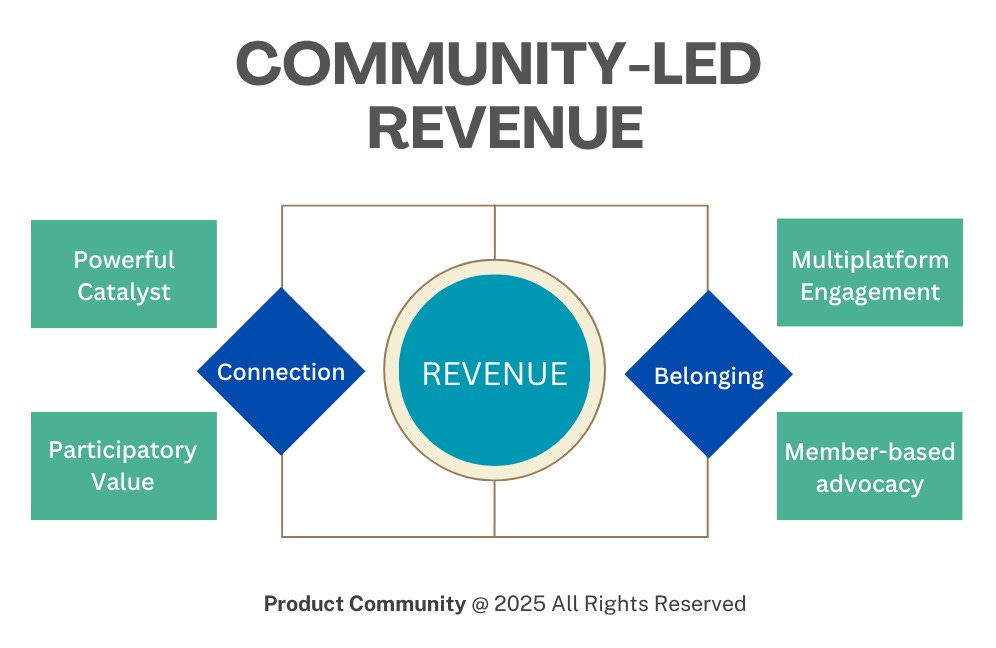Community-Led Revenue
What Associations Can Learn From Two Companies That Masterfully Blend Community Building With Innovative Business Models
Summary
While associations often struggle to balance mission-driven community building with financial sustainability, two companies have successfully cracked this code. Christopher Kimball's Milk Street and Peloton built successful businesses by creating movements that demonstrate how community and commerce can reinforce and serve each other.
When you truly understand your community's needs and create multiple touch points for engagement, you don't have to choose between social impact and financial success. Instead, you can build profitable purpose where revenue growth strengthens community and deepens commitment to mission.
I lead the product community, a product development learning community designed specifically for associations. Let’s compare ideas and build something great.
The Multiplier Effect in Action
"The first rule is that you have to provide something people can’t get somewhere else.”
Christopher Kimball
The foundation of a community is people coming together around shared interests. This can be a profession, an industry, or a compelling problem. Great community builds off the agency afforded by tightly-focused positioning around a compelling value proposition.
In a previous article, I addressed the importance and power of building both bonding capital (engaging with people like us) and bridging capital (engaging with people unlike us). These concepts come from Robert Putnam’s class book Bowling Alone. Two companies — Milk Street and Peloton — demonstrate how social capital can serve as the foundation for building a rabid and loyal following.
Milk Street: Bridging Cultural Culinary Divides
Milk Street's mission is radical in its simplicity: “an invitation to the cooks of the world to sit at the same table.” This philosophy creates powerful bridging capital by connecting home cooks across cultural boundaries through shared culinary experiences.
Bonding Capital: Milk Street subscribers receive digital access to all recipes, print magazine, free shipping in Milk Street Store, online cooking classes, newsletters, and personal recipe box creating a tight-knit community of culinary enthusiasts who share a common approach to cooking.
Bridging Capital: Milk Street breaks down cultural barriers. Rather than treating recipes as belonging to specific peoples and places, Milk Street offers “a culinary not cultural exchange” that brings together “enduring kitchen values that travel easily from Saigon to Kiev to Jerusalem to Quito to London to New York.”
Peloton: Bridging Physical and Digital Fitness Communities
Peloton began with a revolutionary idea: “bring the energy and community of boutique fitness classes to the home.” This created bridging capital by connecting people who couldn't physically be in the same space.
Bonding Capital: Peloton offers social features that allow users to connect with friends, join group workouts, and compete on live leaderboards, creating tight bonds among users who share fitness goals and experiences.
Bridging Capital: Peloton is “committed to nurturing a sense of belonging for all members and reducing barriers to physical and mental well-being” through community partnerships and inclusive programming. The platform connects people across geographic, economic, and physical ability boundaries.
The power of committing to both bonding capital and bridging capital is the basis for creating a powerful community-driven revenue model. Let’s look at how it works in practice.
Innovation Through Community-Driven Business Models
“You didn’t just get a bike, you get the whole community”
Robin Arzon
Community is not software alone. It comes from a deep connection driven by a focused catalyst. This catalyst typically derives from organizations that have powerful identities in a particular niche. Most associations are grounded by their focus on a particular industry or profession. It really is true, there is an association for everyone and everything!
Even though I’m only familiar with Milk Street as a consumer, I like both Peloton’s and Milk Street’s community-first approach. Though Peloton has experienced bumps of late, they are a great example of linking software, hardware, people, and exercise. Milk Street is an omnimedia company that draws people into community by its emphasis on accessible and flavorful cooking and the sharing of knowledge through nearly any format and channel (podcasts, tv, books, recipes, education, etc.).
Milk Street: The Multimedia Ecosystem Approach
Milk Street provides a good example for how associations might create multiple revenue streams that strengthen rather than dilute community engagement:
Content Integration. Milk Street produces and distributes a weekly half-hour television program, a magazine, a cooking school, a weekly radio program, video podcasts, and live cooking events. Each platform reinforces the others while serving different community needs.
Educational Revenue. Since 2020, the Milk Street Cooking School has taught over 600 virtual cooking classes with Milk Street staff and over 250 guests welcoming participants into home kitchens. This creates both revenue diversity and deep community engagement.
Product Integration. The Milk Street Store offers knives, pantry items, cookware, and cookbooks, but these aren't just products. They're tools that enable community members to better participate in the shared culinary experience.
Peloton: The Hardware-Software-Community Trinity
Peloton's success can be traced back to its seamless blend of hardware, software, and community-building, a trifecta that keeps users engaged and motivated.
Hybrid Revenue Model: Peloton operates on a hybrid business model that combines the sale of its high-end fitness equipment and a subscription service. The hardware creates entry barriers that build commitment, while subscriptions provide ongoing revenue and community access.
Instructor-Influencer Strategy: Peloton's instructors are active across social media and interact with members online. They're employees, and so they're invested in the success of the company.
Community-as-Marketing: Peloton paused its marketing because their most cost-effective channel was community-driven growth demonstrating how strong community can replace traditional marketing spend.
Both Milk Street and Peloton demonstrate the power of a crisp identity that speaks to a community interested in deep and long-lasting connection. The power comes in creating a sustainable business by ongoing value loops. A value loop is a recurring interaction between an organization and its customers where both parties exchange and receive value. It's about creating a sustainable cycle of benefit and engagement.
Creating Self-Reinforcing Value Loops
Both companies create value loops where community engagement directly drives business sustainability.
Milk Street's Learning Loop: Members learn techniques through multiple channels (TV, magazine, classes), share experiences in online forums, and purchase tools and ingredients that enable deeper participation. Each touchpoint generates revenue while strengthening community bonds.
Peloton's Motivation Loop: Features like leaderboards, group challenges, and social media sharing create camaraderie among users. It's not just about competing; it's about celebrating milestones together. This emotional investment drives both retention and referrals.
Leveraging Social Capital for Business Innovation
Milk Street's Cultural Capital: By positioning itself as a culinary exchange rather than cultural appropriation, Milk Street taps into diverse cooking traditions while respecting their origins. This approach creates bridging capital that expands market reach.
Peloton's Aspirational Capital: Peloton instructors achieve celebrity status with their followers helping to create aspirational communities that drive equipment sales and subscription renewals.
What might an association glean from these two community-first revenue models? One is creating an ecosystem of related offerings that offer choice and multiple possible revenue streams. Another is based in cross-boundary collaboration and a third is the potential of utilizing the network effect of community to share some of the marketing lift.
Lessons for Association Leaders
“I define community as a group of individuals who share a mutual concern for one another’s welfare.”
Christine Porath
Rethink Your Revenue Model
Milk Street and Peloton demonstrate that community-driven organizations can be profitable. The key is creating multiple revenue streams that strengthen community. They do this in many ways, namely getting good at creating seamless customer experiences combined with cross-platform engagement.
Multi-Platform Integration: Like Milk Street, consider how your association's content can work across multiple channels, each reinforcing the others while serving different member needs and generating different revenue streams.
Membership-Plus Model: Follow Peloton's approach of combining membership with physical or digital products that deepen engagement. What equipment could your association provide that makes member participation more meaningful?
Build Bridges, Not Just Bonds
While bonding capital provides emotional support, bridging capital offers new opportunities and diverse perspectives. Together, they offer the potential to create a resilient network that's deep, wide, alive, and regenerative.
Cross-Boundary Connections: Like Milk Street's global culinary exchange, look for ways your association can connect members across traditional boundaries: geographic, generational, or professional.
Inclusive Growth: Peloton positions itself as “a health and wellness company, not a fitness business,” recognizing that community “comes in different shapes and sizes.” How can your association expand or refine its definition of membership?
Make Community Your Marketing Engine
Peloton's community-first approach led to massive growth (especially during COVID), eventually pausing all traditional marketing because community-led growth was more effective. Both Milk Street and Peloton use story-based experiences to drive engagement.
User-Generated Advocacy: Both companies excel at amplifying member stories and achievements. Peloton routinely shares user-generated content and success stories, with these moments of recognition deepening the emotional connection between the brand and its community.
Create Profitable Purpose. The most powerful lesson from both companies is that purpose and profit can have a multiplier effect. When members see clear value, they actively participate and invest in your ongoing success.
To survive, companies need business models to sustainably demonstrate how to make money. Organizations designed around community have the potential of growing in ways that transcend revenue.
The Path Forward
“Don’t be the ninth person to be the expert on what you’re doing. Be the person. Be really good at one thing.”
Christopher Kimball
I caution against running an association strictly like a business. This may be a recipe for becoming too transactional or chasing shiny objects to drive short-term revenue. I do, however, strongly believe that we can borrow revenue models or business models from any industry, especially ones that understand community and successfully bridge purpose and profit.
Great community has a multiplying effect. Milk Street and Peloton prove that when you build genuine social capital – both bonding and bridging – you can create conditions for sustainable growth that transcend traditional membership models.
Connection is currency and ongoing engagement drives member value. The associations that master the intersection of community and financial stability have the potential to grow in new and authentic ways. Healthy community isn't a cost center, it's our competitive advantage.
I lead the product community; we are a learning community because we believe great relationships help us create the value our members want. Remember, product-led growth fuels connection. Join the product community and flip your destiny.
About the Author
James Young is founder and chief learning officer of the product community®. Jim is an engaging trainer and leading thinker in the worlds of associations, learning communities, and product development. Prior to starting the product community®, Jim served as Chief Learning Officer at both the American College of Chest Physicians and the Society of College and University Planning. Please contact me for a conversation: james@productcommunity.us







